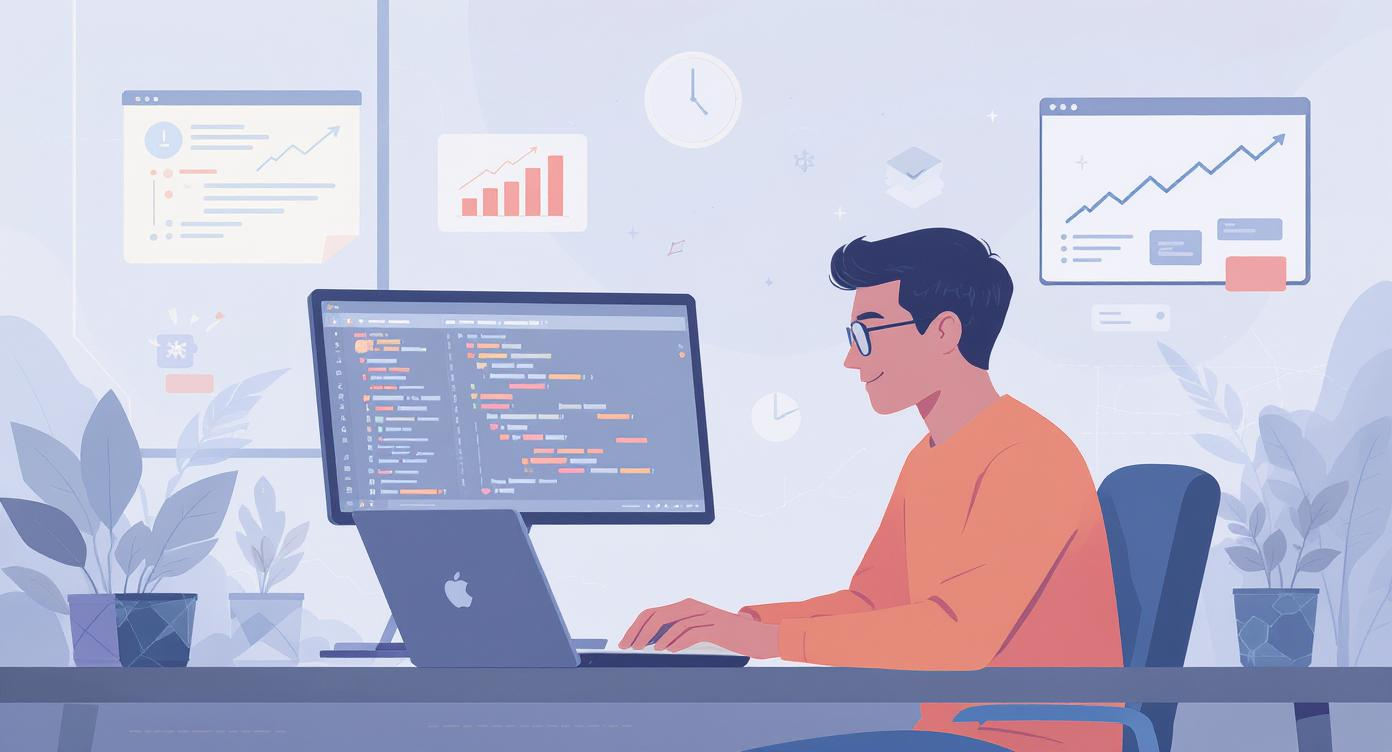
The Internship That Changed Everything: 6 Months That Shaped My Career
This is the story of how a 6-month internship taught me more about software development than 3 years of college combined.
The Application: Shooting My Shot
It was December 2024, and I was scrolling through LinkedIn when I saw a post from ICEICO Technologies looking for web development interns. Most of my classmates were applying to big tech companies for summer internships, but something about this smaller company caught my attention.
Why ICEICO Appealed to Me:
- They were working on real client projects
- Small team meant more responsibility
- Focus on web development (my interest area)
- Based in Nagpur (close to home)
My Application Strategy:
Instead of sending a generic resume, I did something different. I built a simple website showcasing three projects and wrote a personalized email explaining why I wanted to work specifically with them.
Suhas Dhawale - Aspiring Web Developer
Hi ICEICO Team! 👋
I'm Suhas, a 3rd-year CSE student who's passionate about web development.
Here are three projects I've built to show my skills:
Personal Portfolio Website
A responsive portfolio built from scratch
Tech: HTML, CSS, JavaScript
The Email I Sent:
> Subject: Web Development Intern Application - Suhas Dhawale
>
> Dear ICEICO Team,
>
> I've been following your work on healthcare and e-commerce solutions, and I'm impressed by your focus on creating practical, user-friendly applications.
>
> As a 3rd-year CSE student, I've been building web applications for the past year. Instead of just sending my resume, I've created a simple website showcasing my work: [portfolio-link]
>
> I'm particularly excited about the opportunity to work on real client projects and learn from experienced developers. I'm available for a 6-month internship starting January 2025.
>
> Looking forward to hearing from you!
>
> Best regards,
> Suhas Dhawale
The Response:
Three days later, I got a call for an interview. The HR person mentioned that my personalized approach and the simple portfolio website stood out among 200+ applications.
The Interview: More Conversation Than Interrogation
The interview was with the technical lead and the founder. Instead of typical coding questions, they asked about my projects and thought process.
Questions They Asked:
1. "Walk us through your portfolio website. What challenges did you face?"
2. "How would you approach building an e-commerce website?"
3. "What's the difference between frontend and backend development?"
4. "Why do you want to work with a smaller company instead of a big tech firm?"
My Honest Answers:
1. I explained the responsive design challenges and how I solved them
2. I broke down e-commerce into user authentication, product catalog, cart, and payments
3. I gave practical examples from my projects
4. I said I wanted hands-on experience with real projects, not just assigned tasks
The Technical Test:
They gave me a simple task: "Build a basic todo app with HTML, CSS, and JavaScript in 2 hours."
I built it with:
- Add/delete functionality
- Local storage persistence
- Responsive design
- Clean, commented code
The Result:
I got the internship offer the next day!
Week 1: Reality Check
My Expectations:
- I'll be building features immediately
- My college knowledge will be directly applicable
- I'll work on cutting-edge technologies
The Reality:
- First week was setup and understanding existing codebases
- College taught theory; industry needed practical skills
- Most work was on maintaining existing applications
Day 1 Shock:
My first task: Set up the development environment
git clone https://github.com/iceico/healthcare-platform.git
cd healthcare-platform
npm install
47 vulnerabilities found, 23 high severity
npm start
Error: Node version mismatch
Error: Missing environment variables
Error: Database connection failed
It took me 3 days to get the project running locally. In college, everything "just worked" in our controlled environment.
What I Learned in Week 1:
- Real projects have dependencies and configurations
- Documentation is often outdated
- Environment setup is a skill in itself
- Asking for help is not a weakness
Month 1: Learning the Ropes
My First Real Task:
"Fix the contact form on the healthcare website - it's not sending emails properly."
What I Thought It Would Take: 2 hours
What It Actually Took: 3 days
The Journey:
// Day 1: Found the frontend form
const handleSubmit = (e) => {
e.preventDefault();
const formData = new FormData(e.target);
fetch('/api/contact', {
method: 'POST',
body: formData
})
.then(response => response.json())
.then(data => {
if (data.success) {
alert('Message sent successfully!');
}
});
};// Day 2: Discovered the backend API was broken
app.post('/api/contact', (req, res) => {
const { name, email, message } = req.body;
// This was failing silently
sendEmail({
to: 'info@company.com',
subject: 'Contact Form Submission',
body: Name: ${name}\nEmail: ${email}\nMessage: ${message}
});
res.json({ success: true }); // Always returned success!
});
// Day 3: Fixed the email service configuration
const nodemailer = require('nodemailer');
const transporter = nodemailer.createTransport({
service: 'gmail',
auth: {
user: process.env.EMAIL_USER, // This was missing!
pass: process.env.EMAIL_PASS // This too!
}
});
Lessons from My First Task:
1. Always test the full flow - frontend to backend to email delivery
2. Check environment variables - missing config causes silent failures
3. Read error logs carefully - they tell you exactly what's wrong
4. Test edge cases - what happens with invalid emails?
Month 2: Real Responsibility
The Big Project:
"We need to add a shopping cart feature to the mattress e-commerce site. Can you handle it?"
This was my first major feature, and I was terrified and excited.
The Requirements:
- Add products to cart
- Update quantities
- Calculate totals with tax
- Persist cart across sessions
- Mobile-responsive design
My Approach:
// Frontend: React component for cart
import React, { useState, useEffect } from 'react';function ShoppingCart() {
const [cartItems, setCartItems] = useState([]);
const [loading, setLoading] = useState(true);
useEffect(() => {
loadCartFromStorage();
}, []);
const loadCartFromStorage = () => {
const savedCart = localStorage.getItem('cart');
if (savedCart) {
setCartItems(JSON.parse(savedCart));
}
setLoading(false);
};
const addToCart = (product) => {
const existingItem = cartItems.find(item => item.id === product.id);
if (existingItem) {
updateQuantity(product.id, existingItem.quantity + 1);
} else {
const newCart = [...cartItems, { ...product, quantity: 1 }];
setCartItems(newCart);
localStorage.setItem('cart', JSON.stringify(newCart));
}
};
const updateQuantity = (productId, newQuantity) => {
if (newQuantity === 0) {
removeFromCart(productId);
return;
}
const updatedCart = cartItems.map(item =>
item.id === productId ? { ...item, quantity: newQuantity } : item
);
setCartItems(updatedCart);
localStorage.setItem('cart', JSON.stringify(updatedCart));
};
const calculateTotal = () => {
const subtotal = cartItems.reduce((total, item) =>
total + (item.price * item.quantity), 0
);
const tax = subtotal * 0.18; // 18% GST
return { subtotal, tax, total: subtotal + tax };
};
// Rest of the component...
}
Backend: API endpoints
// Laravel controller for cart operations
class CartController extends Controller
{
public function addToCart(Request $request)
{
$request->validate([
'product_id' => 'required|exists:products,id',
'quantity' => 'required|integer|min:1'
]); $user = auth()->user();
$product = Product::find($request->product_id);
$cartItem = Cart::where('user_id', $user->id)
->where('product_id', $product->id)
->first();
if ($cartItem) {
$cartItem->quantity += $request->quantity;
$cartItem->save();
} else {
Cart::create([
'user_id' => $user->id,
'product_id' => $product->id,
'quantity' => $request->quantity,
'price' => $product->price
]);
}
return response()->json([
'success' => true,
'message' => 'Product added to cart'
]);
}
public function getCart()
{
$user = auth()->user();
$cartItems = Cart::with('product')
->where('user_id', $user->id)
->get();
$total = $cartItems->sum(function($item) {
return $item->quantity * $item->price;
});
return response()->json([
'items' => $cartItems,
'total' => $total
]);
}
}
The Challenges I Faced:
1. State Management: Keeping cart state synchronized between components
2. Data Persistence: Handling both logged-in users and guests
3. Price Calculations: Handling discounts, taxes, and currency formatting
4. Mobile Responsiveness: Making the cart work on all screen sizes
Time Taken: 2 weeks (including testing and bug fixes)
Month 3: The Healthcare Project
The Challenge:
"We need to build a patient management system for a local clinic. You'll be the lead developer on this."
Lead developer? I had been an intern for only 2 months, but they trusted me with this responsibility.
Project Scope:
- Patient registration and profiles
- Appointment scheduling
- Medical records management
- Doctor dashboard
- Billing system
The Tech Stack Decision:
// Frontend: React with TypeScript (my suggestion)
interface Patient {
id: string;
name: string;
age: number;
phone: string;
email: string;
medicalHistory: MedicalRecord[];
appointments: Appointment[];
}interface Appointment {
id: string;
patientId: string;
doctorId: string;
date: Date;
time: string;
status: 'scheduled' | 'completed' | 'cancelled';
notes?: string;
}
// Component for appointment scheduling
const AppointmentScheduler: React.FC = () => {
const [selectedDate, setSelectedDate] = useState(new Date());
const [availableSlots, setAvailableSlots] = useState([]);
const [selectedSlot, setSelectedSlot] = useState('');
useEffect(() => {
fetchAvailableSlots(selectedDate);
}, [selectedDate]);
const fetchAvailableSlots = async (date: Date) => {
try {
const response = await fetch(/api/appointments/available-slots?date=${date.toISOString()});
const slots = await response.json();
setAvailableSlots(slots);
} catch (error) {
console.error('Failed to fetch available slots:', error);
}
};
// Rest of the component...
};
Backend: Laravel with proper architecture
// Models with relationships
class Patient extends Model
{
protected $fillable = [
'name', 'age', 'phone', 'email', 'address', 'emergency_contact'
]; public function appointments()
{
return $this->hasMany(Appointment::class);
}
public function medicalRecords()
{
return $this->hasMany(MedicalRecord::class);
}
}
class Appointment extends Model
{
protected $fillable = [
'patient_id', 'doctor_id', 'appointment_date',
'appointment_time', 'status', 'notes'
];
protected $casts = [
'appointment_date' => 'date',
'appointment_time' => 'datetime'
];
public function patient()
{
return $this->belongsTo(Patient::class);
}
public function doctor()
{
return $this->belongsTo(Doctor::class);
}
}
// Service class for business logic
class AppointmentService
{
public function scheduleAppointment($patientId, $doctorId, $date, $time)
{
// Check if slot is available
$existingAppointment = Appointment::where('doctor_id', $doctorId)
->where('appointment_date', $date)
->where('appointment_time', $time)
->where('status', '!=', 'cancelled')
->first();
if ($existingAppointment) {
throw new Exception('Time slot is already booked');
}
// Create appointment
$appointment = Appointment::create([
'patient_id' => $patientId,
'doctor_id' => $doctorId,
'appointment_date' => $date,
'appointment_time' => $time,
'status' => 'scheduled'
]);
// Send confirmation SMS/Email
$this->sendAppointmentConfirmation($appointment);
return $appointment;
}
private function sendAppointmentConfirmation($appointment)
{
// SMS and email notification logic
}
}
What I Learned:
1. Architecture Matters: Proper separation of concerns makes code maintainable
2. User Experience: Healthcare software needs to be intuitive for non-tech users
3. Data Security: Patient data requires extra security measures
4. Testing: Healthcare software needs thorough testing
Project Timeline:
- Week 1: Requirements gathering and database design
- Week 2-3: Backend API development
- Week 4-5: Frontend development
- Week 6: Integration and testing
- Week 7: Deployment and training
The Result:
The clinic is still using the system today, and it handles 50+ appointments per day.
Month 4-5: Becoming a Mentor
New Responsibility:
Two new interns joined, and I was asked to mentor them. Teaching others taught me how much I had learned.
What I Taught Them:
1. Git Workflow: Proper branching, commit messages, pull requests
2. Code Review: How to give and receive feedback
3. Debugging: Systematic approach to finding and fixing bugs
4. Best Practices: Clean code, documentation, testing
Mentoring Challenges:
- Explaining concepts I had learned intuitively
- Being patient with begin mistakes I had made
- Balancing guidance with letting them learn from mistakes
Git Workflow I Taught:
Feature branch workflow
git checkout -b feature/user-authentication
Make changes
git add .
git commit -m "Add user login functionality- Implement JWT token authentication
- Add password hashing with bcrypt
- Create login/logout API endpoints
- Add form validation on frontend"
git push origin feature/user-authentication
Create pull request for code review
Month 6: The Final Project
The Challenge:
"We want to rebuild our company website. Can you lead this project?"
This was my chance to apply everything I had learned.
Project Requirements:
- Modern, responsive design
- Content management system
- SEO optimization
- Performance optimization
- Mobile-first approach
My Tech Stack Choice:
// Next.js for full-stack development
// pages/api/blog/[slug].js
export default async function handler(req, res) {
const { slug } = req.query; if (req.method === 'GET') {
try {
const post = await getBlogPost(slug);
if (!post) {
return res.status(404).json({ error: 'Post not found' });
}
res.status(200).json(post);
} catch (error) {
res.status(500).json({ error: 'Failed to fetch post' });
}
}
}
// components/BlogPost.jsx
import { useState, useEffect } from 'react';
import Head from 'next/head';
export default function BlogPost({ slug }) {
const [post, setPost] = useState(null);
const [loading, setLoading] = useState(true);
useEffect(() => {
fetchPost(slug);
}, [slug]);
const fetchPost = async (slug) => {
try {
const response = await fetch(/api/blog/${slug});
const postData = await response.json();
setPost(postData);
} catch (error) {
console.error('Failed to fetch post:', error);
} finally {
setLoading(false);
}
};
if (loading) return
Loading...;
if (!post) return Post not found; return (
<>
{<code class="bg-gray-100 dark:bg-gray-800 px-2 py-1 rounded text-sm font-mono text-blue-600 dark:text-blue-400">${post.title} | ICEICO Technologies</code>}
{post.title}
);
}
Performance Optimizations I Implemented:
1. Image Optimization: Next.js Image component with lazy loading
2. Code Splitting: Dynamic imports for heavy components
3. Caching: API responses and static assets
4. SEO: Meta tags, structured data, sitemap
The Results:
- Page Load Time: Reduced from 4.2s to 1.1s
- SEO Score: Improved from 65 to 94
- Mobile Performance: 95/100 on Google PageSpeed
- Conversion Rate: 40% increase in contact form submissions
The Skills I Gained
Technical Skills
1. Frontend Development: React, Next.js, TypeScript, responsive design
2. Backend Development: Node.js, Laravel, API design, database optimization
3. DevOps: Git workflow, deployment, performance monitoring
4. Testing: Unit tests, integration tests, user acceptance testing
Soft Skills
1. Communication: Explaining technical concepts to non-technical stakeholders
2. Project Management: Breaking down large projects into manageable tasks
3. Problem Solving: Systematic debugging and troubleshooting
4. Mentoring: Teaching and guiding junior developers
Business Skills
1. Client Interaction: Understanding requirements and managing expectations
2. Time Management: Balancing multiple projects and deadlines
3. Quality Assurance: Ensuring deliverables meet professional standards
4. Documentation: Writing clear, maintainable code and documentation
The Transformation
Before Internship:
- Knew syntax but not architecture
- Built toy projects, not real applications
- Worked alone, never in a team
- Focused on making it work, not making it maintainable
After Internship:
- Understood software architecture and design patterns
- Built production applications used by real users
- Collaborated effectively with designers, project managers, and other developers
- Focused on code quality, performance, and user experience
Lessons That Changed My Perspective
1. Code Quality Matters More Than Clever Code
// Before: Trying to be clever
const getUserData = (users, id) => users.find(u => u.id === id) || {};// After: Being clear and maintainable
const getUserById = (users, userId) => {
const user = users.find(user => user.id === userId);
if (!user) {
console.warn(User with ID ${userId} not found);
return null;
}
return user;
};
2. User Experience Trumps Technical Perfection
It's better to have a simple solution that works well for users than a complex solution that's technically impressive but confusing.
3. Communication is as Important as Coding
The best code in the world is useless if you can't explain it to your team or if it doesn't solve the user's problem.
4. Learning Never Stops
Technology evolves rapidly. The ability to learn and adapt is more valuable than knowing specific technologies.
Advice for Future Interns
Before Applying
1. Build a portfolio - even simple projects show your passion
2. Learn Git basics - you'll use it from day one
3. Understand web fundamentals - HTML, CSS, JavaScript, HTTP
4. Practice problem-solving - not just coding syntax
During the Internship
1. Ask questions - it's better to ask than to assume
2. Take notes - you'll forget important details
3. Volunteer for challenges - growth happens outside your comfort zone
4. Build relationships - your colleagues are your future network
After the Internship
1. Stay in touch - maintain professional relationships
2. Apply what you learned - build projects using new skills
3. Share your experience - help other students
4. Keep learning - the internship is just the beginning
The Long-Term Impact
This internship didn't just teach me technical skills - it shaped my career trajectory:
Immediate Impact:
- Got a pre-placement offer from ICEICO
- Built confidence in my abilities
- Developed a professional network
- Gained real-world experience
Long-Term Impact:
- Started freelancing with confidence
- Built my own SaaS application
- Became a mentor to other students
- Developed entrepreneurial mindset
Final Thoughts
Six months at ICEICO Technologies transformed me from a student who knew how to code into a developer who could build real solutions for real problems.
The Most Important Lesson:
There's a huge difference between knowing how to code and knowing how to develop software professionally.
College teaches you the syntax and theory. Internships teach you how to apply that knowledge to solve real problems, work with real teams, and build real products that real people use.
My Advice:
Don't just look for internships at big tech companies. Sometimes, smaller companies offer better learning opportunities because you get more responsibility and exposure to the entire development process.
To ICEICO Technologies:
Thank you for taking a chance on a curious student and giving me the opportunity to grow. The skills and confidence I gained during those six months continue to benefit me every day.
To Future Interns:
Your internship is what you make of it. Be curious, be proactive, and be willing to learn from mistakes. The experience will shape your career in ways you can't imagine.
---
Currently looking for internship opportunities or want to share your own internship experience? I'd love to connect and hear your story! Find me through below mentioned links.
Want to see the projects I built during my internship? Check out my portfolio to see the real-world applications and the lessons learned from each one.
Suhas Dhawale
Full Stack Developer & Computer Science Engineering student passionate about creating modern, responsive web applications. Currently building SaaS products and sharing the journey through real stories and practical insights.

